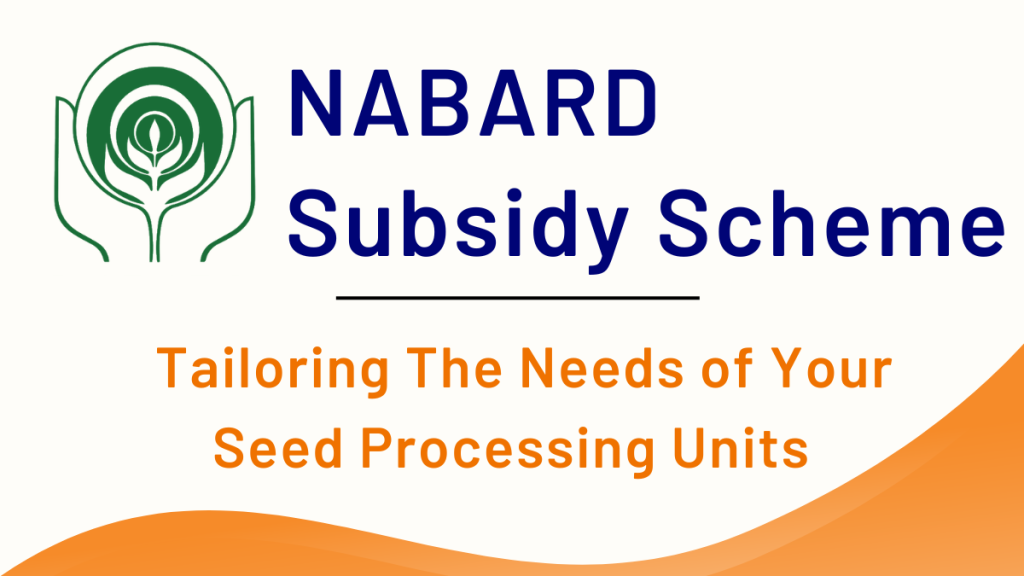The NABARD (National Bank for Agricultural and Rural Development) Grant Scheme is a critical accelerator for improving agricultural and rural development in India. Consider this program a lifeline that provides financial assistance to farmers, rural businesses, and groups devoted to improving agricultural and rural environments. In this article, we’ll look at the whole NABARD Subsidy Scheme, from its main aims and the myriads of advantages it provides to the qualifying requirements, application procedure, and grant kinds it covers. We’ll break it all down into clear, well-organized tables to make the information as accessible as possible. Join us as we explore how this strategy may dramatically affect and boost your agricultural or rural development.

Introduction to NABARD
The primary purpose of NABARD’s establishment in 1982 was to recognize and promote the improvement and expansion of rural infrastructure, rural industries, and agriculture. It aims to enhance rural financial inclusion by giving grants and help for activities that benefit their economies.
Objectives of the NABARD Financial Support Program
The NABARD Subsidy Scheme aims to promote rural development by giving financial support to agricultural and rural initiatives. It aims to improve farmers’ livelihoods and nurture long-term growth in the rural economy through targeted subsidies and support measures.
The NABARD Subsidy Scheme aims to:
Enhance Agricultural Productivity: The goal is to transform farming efficiency by investing in advanced agricultural technologies and infrastructure. This assistance allows farmers to incorporate innovative techniques and technologies, leading to record-breaking harvests and profits, ultimately changing the face of contemporary farming.
Promote Rural Businesses: Supporting small and medium enterprises (SMEs) in rural areas aims to spark job growth and economic health. This method promotes local business growth, creates various income sources, and reduces the movement of people to cities, which strengthens rural economies and encourages sustainable community growth.
Promote the development of rural infrastructure: Investing in essential rural infrastructure like advanced irrigation systems, upgraded rural roads, and contemporary storage facilities is intended to revamp agricultural transportation. This advancement reduces post-harvest waste and improves market access, setting the stage for rural progress and improved efficiency.
Promote Sustainable Practices: Supporting eco-conscious agricultural methods aims to balance productivity and environmental conservation. The initiative prioritizes sustainable practices to conserve resources, decrease ecological footprints, and maintain the viability of farming for future generations, ultimately promoting a more environmentally friendly and robust agricultural industry.
These goals hold profound significance for national progress. Elevating agricultural productivity and infrastructure, bolstering rural enterprises, and advocating sustainability are not just measures of growth but keystones of a thriving, resilient economy. These efforts promise to transform rural landscapes, stimulate economic opportunities, and ensure environmental balance, thus propelling our nation towards a more prosperous and sustainable future.
NABARD Subsidy Program Types
NABARD offers diverse subsidy schemes tailored to different needs and sectors. Here are some of the key schemes:
Rural Development Infrastructure Fund
The RIDF is an important component of the NABARD Subsidy Scheme aimed at funding foundation projects in rural areas. It covers:
- Building and enhancing irrigation infrastructure is known as irrigation projects.
- Rural Roads: Founding networks of rural roads to enhance connectivity.
- Storage Facilities: Building warehouses and cold storage spaces.
| Feature | Details |
| Target Areas | Rural infrastructure projects |
| Funding | 100% financial assistance for eligible projects |
| Eligibility | State governments, rural local bodies, and cooperatives |
| Application | Through NABARD regional offices or online portals |
National Agricultural Insurance Scheme
The National Agricultural Insurance Scheme (NAIS) offers vital protection for farmers facing crop losses due to natural calamities like floods, droughts, and pest invasions. Key highlights encompass extensive risk coverage, affordable premium rates, swift claim processing, and incentives for embracing advanced agricultural methods to prevent future losses. The scheme also covers:
- Losses resulting from floods, droughts, and other natural catastrophes are covered.
- Premium Subsidy: An amount towards the insurance premium is given to farmers.
- Claim Process: A smooth procedure for resolving claims.
| Feature | Details |
| Coverage | Crop loss due to natural calamities |
| Premium Subsidy | Provided to farmers based on crop type and region |
| Claim Settlement | Fast and efficient claim process |
| Eligibility | All farmers with insured crops |
Micro Irrigation Fund (MIF)
The Micro Irrigation Fund (MIF) aims to promote efficient water use through advanced techniques like drip and sprinkler systems. Key aspects include enhanced water efficiency, reduced wastage, cost savings, and increased crop yields. The Micro Irrigation Fund also includes full or partial compensation for the installation of micro irrigation systems with a goal to cut down on waste and improve the efficiency of water use.
| Feature | Details |
| Funding | Subsidy on installation of micro irrigation systems |
| Eligibility | Farmers and agricultural cooperatives |
| Application | Through NABARD or state agricultural departments |
Eligibility Criteria
Eligibility for NABARD subsidy schemes varies depending on the specific program. Generally, the criteria include the type of applicant (e.g., individual farmers, farmer groups, or organizations), the nature of the project (e.g., agricultural development, rural infrastructure), land ownership or lease status, and adherence to sustainable practices. The eligibility criteria for different schemes is as follows:
For RIDF: State governments, rural local bodies, and cooperatives engaged in infrastructure development.
For NAIS: Farmers with insured crops, including those under various government schemes.
For the Micro Irrigation Fund (MIF): eligible candidates include innovative farmers and cooperative societies engaged in projects enhancing water use efficiency and sustainable irrigation practices.
| Scheme | Eligibility |
| RIDF | State governments, rural local bodies, cooperatives |
| NAIS | Farmers with insured crops |
| MIF | Farmers, agricultural cooperatives |
Application Process
Applying for NABARD subsidies involves multiple steps, including assessing eligibility, preparing project proposals, submitting necessary documentation, undergoing a thorough evaluation, and meeting specific compliance requirements for approval and disbursement. The following steps cover the application process for a NABARD scheme.
Preparation: Identify the scheme that suits your project or need.
Documentation: Prepare the required records, including financial statements, project reports, and eligibility documentation.
Submission: Send the application online or through the appropriate NABARD regional office.
Depending on the applicant’s eligibility and the viability of the project, NABARD will evaluate the proposal and provide approval. The subsidy amount will be distributed in accordance with the terms of the program when it has been authorized.
| Step | Details |
| Preparation | Identify relevant schemes and prepare documents |
| Submission | Submit application to NABARD or the online portal |
| Review | NABARD reviews applications and approves |
| Disbursement | Subsidy amount released upon approval |
Advantages of the NABARD Assistance Program
The NABARD Subsidy Scheme presents a wealth of advantages, providing vital financial aid for agricultural and rural ventures, along with reduced loan interest rates. It champions sustainable farming, fosters infrastructural growth, spurs innovation, and significantly boosts rural employment. By enabling access to cutting-edge technology and resources, it enhances farmers’ incomes and promotes economic resilience in rural areas.
Financial Support: By offering subsidies for different projects, NABARD schemes aim to lessen the financial load on recipients.
Enhanced Productivity: NABARD schemes use infrastructure and contemporary technologies to increase agricultural productivity.
Employment Generation: The schemes offered by NABARD promote rural businesses and infrastructural initiatives to generate jobs in rural regions.
Sustainability: Sustainable development encourages resource efficiency and sustainable farming methods through NABARD schemes.
Challenges and Solutions
Although the NABARD Subsidy Scheme offers numerous benefits, it faces challenges such as bureaucratic delays, limited awareness among farmers, complex application processes, and difficulty in reaching remote rural areas effectively.
Awareness: Limited awareness about the scheme among rural populations.
Solution: Increase outreach and educational programs to inform potential beneficiaries.
Bureaucratic Hurdles: Complex application procedures can be a barrier.
Solution: smooth processes and provide clear guidelines for candidates.
Disbursement Delays: Project implementation may be impacted by delays in the disbursement of subsidies.
Solution: Implement efficient systems for timely disbursement.
Success Stories
NABARD subsidies have been used to support several successful initiatives, illustrating the effectiveness of the program:
Farmers Using Drip Irrigation: Thanks to the MIF program, farmers in Maharashtra have greatly boosted both the output of their crops and the efficiency with which they use water.
Rural Infrastructure Projects: By providing funding for various rural road projects, the RIDF has increased market accessibility and connectivity.
Prospects and Developments for the Future: Over time, the NABARD Subsidy Scheme has changed to accommodate the evolving demands of rural development and agriculture. Several patterns and advancements are anticipated to influence the scheme’s future going forward:
Integration with Technology: Technological developments are poised to revolutionize subsidy management and disbursement. Future advancements may include blockchain for secure transactions, AI for efficient processing, mobile apps for accessibility, and real-time monitoring systems.
Digital Platforms: Enhanced online platforms for application submissions, tracking, and management.
Data analytics: Apply data analytics to enhance project outcomes and more effectively target subsidies.
Emphasize sustainable practices: As environmental challenges gain greater recognition, supporting initiatives that promote sustainability will likely receive increased focus, fostering eco-friendly practices, encouraging resource conservation, and ensuring long-term environmental health and resilience.
Climate-Resilient Farming: As farming techniques become more prevalent, subsidies may be used to assist them.
Renewable Energy Projects: Financial support for initiatives involving renewable energy sources in rural regions.
Expanded Outreach: Ongoing efforts to expand beneficiary reach and improve awareness of the scheme are anticipated to intensify, aiming to broaden participation, enhance understanding, and ensure that more individuals benefit from available resources.
Community Programs: Increased community outreach and educational programs to inform rural populations.
Partnerships: Collaboration with local organizations and NGOs to extend the scheme’s reach.
Conclusion
An important program to support from rural and agricultural development in India is the NABARD Subsidy Scheme. It boosts productivity, encourages sustainable practices, and supports rural businesses by giving financial support for a range of initiatives. Rural development is significantly impacted by continuous attempts to enhance the outreach and execution of the strategy, despite obstacles.
Understanding the different plans, eligibility requirements, and application processes is crucial for anybody interested in taking advantage of the NABARD Subsidy Scheme. Individuals and groups may support the expansion and improvement of rural India by taking advantage of these possibilities.
For NABARD aspirants, ixamBee offers a comprehensive NABARD Mock Test series that replicates the actual exam environment, delivering invaluable practice and insights. Stay ahead of the curve with the latest NABARD Notifications, ensuring you never miss crucial updates regarding exam dates, application procedures, and other essential information. Embrace ixamBee’s NABARD resources and transform your preparation into a strategic, efficient, and goal-oriented journey.
To help you prepare 50% faster for competitive exams, ixamBee provides free Mock Test Series and all the Current Affairs in English and Current Affairs in Hindi in the BeePedia capsules for GA Preparation. You can also get the latest updates for Bank PO, Bank Clerk, SSC, RBI Grade B, NABARD, and Other Government Jobs.
Also Read:
How many Schemes do I Need to Prepare for NABARD and RBI Grade B?
Government Schemes for NABARD Grade A














